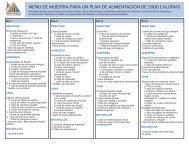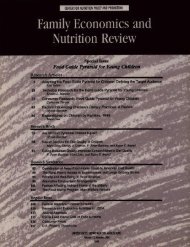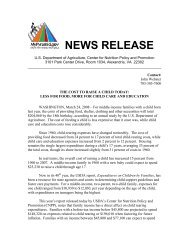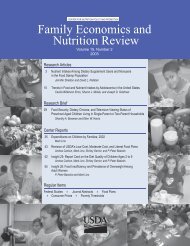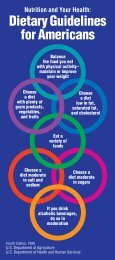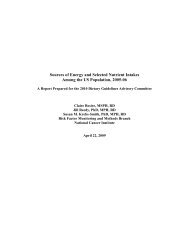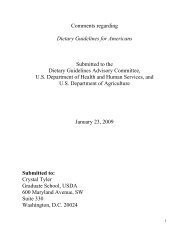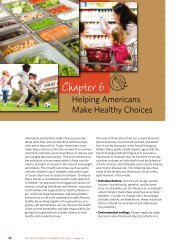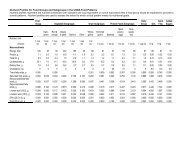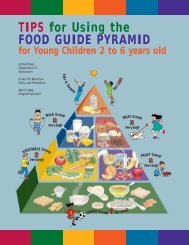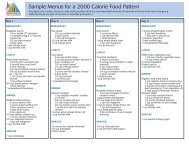Elderly Nutrition - Center for Nutrition Policy and Promotion - US ...
Elderly Nutrition - Center for Nutrition Policy and Promotion - US ...
Elderly Nutrition - Center for Nutrition Policy and Promotion - US ...
Create successful ePaper yourself
Turn your PDF publications into a flip-book with our unique Google optimized e-Paper software.
School Lunch Program: Ef<strong>for</strong>ts Needed to Improve <strong>Nutrition</strong> <strong>and</strong> Encourage Healthful Eating<br />
A recent study by the Federal Government’s General Accounting Office found that although schools are moving toward<br />
meeting school lunch requirements, more improvements are needed. Lunches meet requirements <strong>for</strong> nutrients such as protein,<br />
vitamins, calcium, <strong>and</strong> iron, but they do not meet the st<strong>and</strong>ards <strong>for</strong> dietary fat. Also, ef<strong>for</strong>ts to encourage healthful eating<br />
could be increased. Most students have access to foods of little nutritional value, such as soft drinks <strong>and</strong> c<strong>and</strong>y, at school.<br />
Students may need more exposure to nutrition education to make positive changes in behavior. Barriers to providing<br />
nutritious meals <strong>and</strong> encouraging healthful eating included budget pressures <strong>and</strong> competing time dem<strong>and</strong>s. However,<br />
schools had taken a variety of innovative steps to overcome barriers.<br />
School lunches contain more<br />
vitamin A <strong>and</strong> C<br />
In 1991-92 <strong>and</strong> 1998-99, the mean<br />
nutrient content of elementary <strong>and</strong><br />
secondary school lunches met the<br />
National School Lunch Program<br />
st<strong>and</strong>ards <strong>for</strong> vitamin A (300 mcg RE<br />
or more <strong>for</strong> secondary school lunches)<br />
<strong>and</strong> vitamin C (18 mg or more <strong>for</strong><br />
secondary school lunches). For both of<br />
these vitamins, the mean school lunch<br />
content increased over this time. In<br />
secondary schools, the mean vitamin A<br />
<strong>and</strong> C content of school lunches<br />
increased 24 percent.<br />
Mean vitamin A <strong>and</strong> C content of secondary school lunches<br />
Micrograms RE<br />
600<br />
500<br />
400<br />
300<br />
200<br />
100<br />
0<br />
418<br />
519<br />
1991-92 1998-99<br />
Vitamin A<br />
Milligrams<br />
50<br />
40<br />
30<br />
20<br />
10<br />
0<br />
34<br />
42<br />
1991-92 1998-99<br />
Vitamin C<br />
However, school lunches do<br />
not meet st<strong>and</strong>ards <strong>for</strong> dietary fat<br />
In 1991-92 <strong>and</strong> 1998-99, elementary<br />
<strong>and</strong> secondary school lunches did not<br />
meet the dietary st<strong>and</strong>ards <strong>for</strong> total<br />
<strong>and</strong> saturated fat: 30 percent or less<br />
of calories from total fat <strong>and</strong> 10<br />
percent or less of calories from<br />
saturated fat. School lunches had been<br />
moving toward the st<strong>and</strong>ards over this<br />
time. In secondary schools, the average<br />
percentage of calories from total fat in<br />
school lunches declined 4 percentage<br />
points <strong>and</strong> from saturated fat,<br />
3 percentage points.<br />
Average total <strong>and</strong> saturated fat content of secondary school lunches<br />
Percentage calories from fat<br />
40<br />
30<br />
20<br />
10<br />
0<br />
38%<br />
34%<br />
15%<br />
12%<br />
1991-92 1998-99 1991-92 1998-99<br />
Total fat<br />
Saturated fat<br />
94 Family Economics <strong>and</strong> <strong>Nutrition</strong> Review



